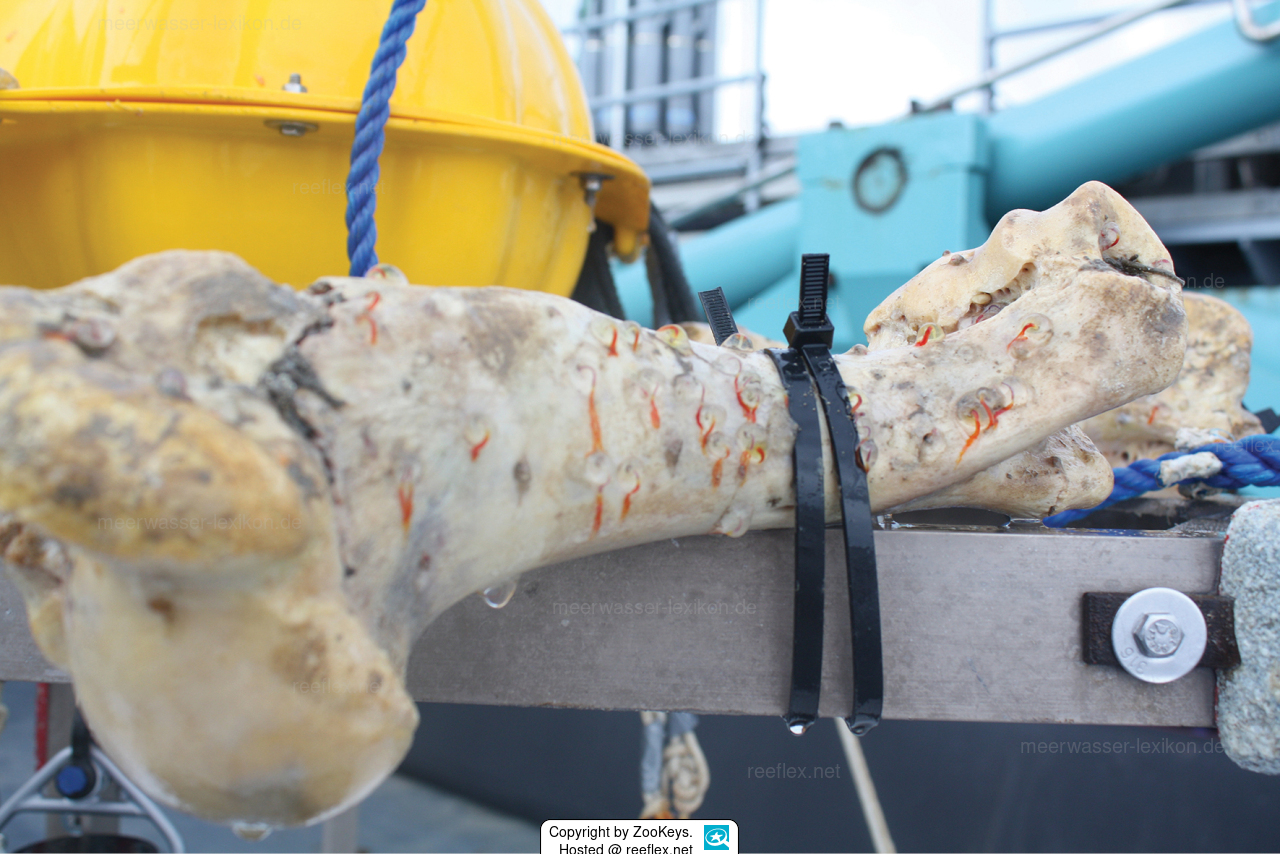Info
Dead whale carcasses are one of the most remarkable sources of energy for a variety of deep-sea organisms when they sink and reach the deep-sea floor, a process known as whale fall. During the decomposition process, which can take several years to decades, they become a habitat island for many species.
The enormous input of organic material from whale falls supports diverse ecosystems rich in opportunistic species that can tolerate the degradation of organic material.
Nevertheless, as with vents and seeps, these ecosystems may support unique and specialized species and communities.
The study of these communities has revealed some remarkable new species, including the annelid genus Osedax Rouse, Goffredi & Vrijenhoek, 2004 (Siboglinidae), a group of organisms that specialize in the digestion of the bones and teeth of dead marine vertebrates. Osedax taxa lack a digestive system and have a special endosymbiotic relationship with heterotrophic bacteria found in the branched root system that excavates the bone.
The symbiotic bacteria are able to metabolize complex carbon compounds in the bone, providing nutrients to both the symbionts and the Osedax hosts.
Osedax specimens also typically exhibit pronounced sexual dimorphism, with females able to reach 1–10 cm and males being microscopically small dwarfs (paedomorphic) and living in harems attached to the female's proboscis.
The genus currently includes 33 described species in all ocean basins, with a wide bathymetric range from 21 to 4,204 meters.
More than half of the named species were first collected on the California margin, where most and longest studies on whale fall exist.
Distribution: Known from the continental margin off São Paulo state, Santos basin, Brazil, at a depth of 550 m; on experimentally deployed cow bones.
Etymology Osedax nataliae is named after Natalia Gularte, the mother of first author Thammy Gularte.
Literature reference:
Gularte T, Sumida PYG, Bergamo G, Rouse GW (2024)
Description of a new Osedax (Annelida, Polychaeta, Siboglinidae) species colonizing cow bones in the South Atlantic Ocean.
ZooKeys 1219: 215-231. https://doi.org/10.3897/zookeys.1219.134005
The enormous input of organic material from whale falls supports diverse ecosystems rich in opportunistic species that can tolerate the degradation of organic material.
Nevertheless, as with vents and seeps, these ecosystems may support unique and specialized species and communities.
The study of these communities has revealed some remarkable new species, including the annelid genus Osedax Rouse, Goffredi & Vrijenhoek, 2004 (Siboglinidae), a group of organisms that specialize in the digestion of the bones and teeth of dead marine vertebrates. Osedax taxa lack a digestive system and have a special endosymbiotic relationship with heterotrophic bacteria found in the branched root system that excavates the bone.
The symbiotic bacteria are able to metabolize complex carbon compounds in the bone, providing nutrients to both the symbionts and the Osedax hosts.
Osedax specimens also typically exhibit pronounced sexual dimorphism, with females able to reach 1–10 cm and males being microscopically small dwarfs (paedomorphic) and living in harems attached to the female's proboscis.
The genus currently includes 33 described species in all ocean basins, with a wide bathymetric range from 21 to 4,204 meters.
More than half of the named species were first collected on the California margin, where most and longest studies on whale fall exist.
Distribution: Known from the continental margin off São Paulo state, Santos basin, Brazil, at a depth of 550 m; on experimentally deployed cow bones.
Etymology Osedax nataliae is named after Natalia Gularte, the mother of first author Thammy Gularte.
Literature reference:
Gularte T, Sumida PYG, Bergamo G, Rouse GW (2024)
Description of a new Osedax (Annelida, Polychaeta, Siboglinidae) species colonizing cow bones in the South Atlantic Ocean.
ZooKeys 1219: 215-231. https://doi.org/10.3897/zookeys.1219.134005







 ZooKeys
ZooKeys



